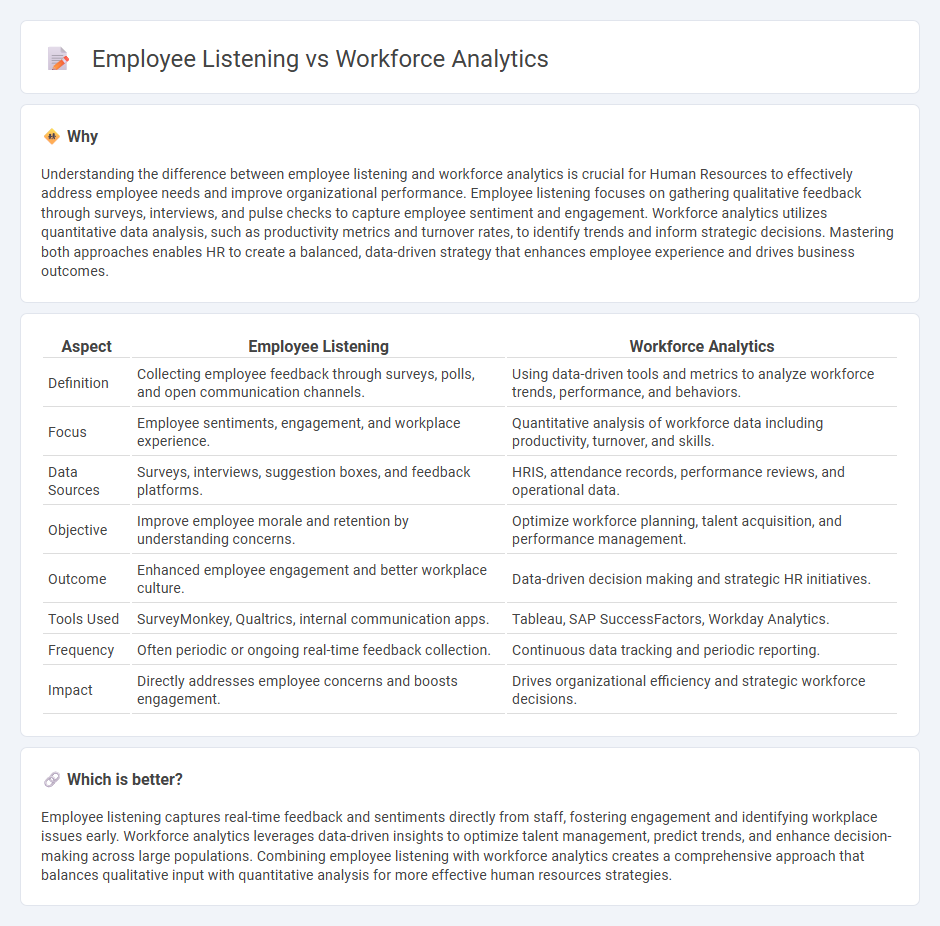
Employee listening captures real-time feedback and sentiments through surveys, focus groups, and direct communication channels, enabling organizations to understand workforce needs and concerns. Workforce analytics leverages data from HR systems to analyze patterns in performance, turnover, and engagement, providing actionable insights to drive strategic decisions. Explore how integrating employee listening with workforce analytics can transform human resources management for better talent retention and productivity.
Why it is important
Understanding the difference between employee listening and workforce analytics is crucial for Human Resources to effectively address employee needs and improve organizational performance. Employee listening focuses on gathering qualitative feedback through surveys, interviews, and pulse checks to capture employee sentiment and engagement. Workforce analytics utilizes quantitative data analysis, such as productivity metrics and turnover rates, to identify trends and inform strategic decisions. Mastering both approaches enables HR to create a balanced, data-driven strategy that enhances employee experience and drives business outcomes.
Comparison Table
| Aspect | Employee Listening | Workforce Analytics |
|---|---|---|
| Definition | Collecting employee feedback through surveys, polls, and open communication channels. | Using data-driven tools and metrics to analyze workforce trends, performance, and behaviors. |
| Focus | Employee sentiments, engagement, and workplace experience. | Quantitative analysis of workforce data including productivity, turnover, and skills. |
| Data Sources | Surveys, interviews, suggestion boxes, and feedback platforms. | HRIS, attendance records, performance reviews, and operational data. |
| Objective | Improve employee morale and retention by understanding concerns. | Optimize workforce planning, talent acquisition, and performance management. |
| Outcome | Enhanced employee engagement and better workplace culture. | Data-driven decision making and strategic HR initiatives. |
| Tools Used | SurveyMonkey, Qualtrics, internal communication apps. | Tableau, SAP SuccessFactors, Workday Analytics. |
| Frequency | Often periodic or ongoing real-time feedback collection. | Continuous data tracking and periodic reporting. |
| Impact | Directly addresses employee concerns and boosts engagement. | Drives organizational efficiency and strategic workforce decisions. |
Which is better?
Employee listening captures real-time feedback and sentiments directly from staff, fostering engagement and identifying workplace issues early. Workforce analytics leverages data-driven insights to optimize talent management, predict trends, and enhance decision-making across large populations. Combining employee listening with workforce analytics creates a comprehensive approach that balances qualitative input with quantitative analysis for more effective human resources strategies.
Connection
Employee listening captures real-time feedback and sentiments, providing qualitative and quantitative data crucial for workforce analytics. Workforce analytics processes this data to identify trends, predict turnover, and improve employee engagement strategies. Together, they enable Human Resources to make data-driven decisions that enhance organizational performance and employee satisfaction.
Key Terms
**Workforce Analytics:**
Workforce analytics leverages data-driven insights to optimize talent management, predict employee performance, and enhance organizational productivity by analyzing metrics such as turnover rates, absenteeism, and engagement levels. This approach integrates advanced technologies like artificial intelligence and machine learning to identify patterns and inform strategic decisions in HR processes. Discover how workforce analytics can transform your business outcomes through precise, actionable intelligence.
Data Modeling
Workforce analytics leverages advanced data modeling techniques to analyze vast employee datasets, identifying trends and predicting workforce outcomes. Employee listening primarily collects qualitative feedback, providing rich insights that complement quantitative data models by revealing employee sentiment and engagement levels. Explore deeper into how integrating these approaches enhances workforce decision-making and performance.
Key Performance Indicators (KPIs)
Workforce analytics leverages data-driven insights to measure Key Performance Indicators (KPIs) such as productivity, turnover rates, and employee engagement levels, enabling organizations to optimize performance outcomes. Employee listening focuses on gathering qualitative feedback through surveys and sentiment analysis to understand employee satisfaction, morale, and areas for improvement that impact KPIs indirectly. Explore how integrating both approaches can provide a comprehensive view of workforce dynamics and drive strategic decision-making.
Source and External Links
Workforce Analytics: Examples and Best Practices - Lightcast - Workforce analytics uses data to measure and improve workforce performance, align HR strategies with business goals, and predict future trends like employee turnover and skill demands through advanced analytics techniques.
What Is Workforce Analytics? Your 2025 A-Z Guide - AIHR - Workforce analytics systematically analyzes workforce data through descriptive, diagnostic, and predictive approaches to understand trends, discover reasons behind issues, and forecast future workforce needs to optimize HR decision-making.
Workforce Analytics: A Comprehensive Guide - ActivTrak - Workforce analytics collects and analyzes employee data across all work settings to provide insights that enhance employee engagement, reduce burnout, and improve productivity through data-driven management decisions.
 dowidth.com
dowidth.com